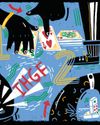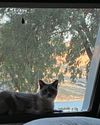
Imagine a large herd of wild horses running free. Americans might picture them in a Western U.S. state like Montana, Wyoming, or Nevada. But just a three-hour drive from the bustling city of Washington, DC, is a unique island called Assateague. There, hundreds of wild ponies have run free along the beaches and through the forests for centuries.
Assateague and Chincoteague
Assateague is what's known as a barrier island, which is a long, relatively narrow island running parallel to a mainland. Thirty-seven miles (60 km) long, Assateague Island sits just off the eastern coast of the Delmarva Peninsula, a landmass that spans three states. The peninsula's unusual location is how it got its name: Del for Delaware, mar for Maryland, and va for Virginia. The island of Assateague itself is split between Maryland and Virginia. And, as if they knew, the ponies have separated themselves into two herds, one on either side of the state line. The Virginia herd is called the Chincoteague ponies, in honor of another small island next door.
The ponies of Assateague "are very much all over the island-very in tune with their surroundings," says Billy Weiland. He's a water specialist at the Assateague Coastal Trust. Sometimes the ponies gather in the forest to keep out of the wind, he says. During the summer, you'll see them trotting through the surf.
So, how did all these wild ponies get there? Stories abound. One tale says they are the descendants of horses that escaped after a Spanish galleon wrecked offshore in 1750. But the most commonly accepted story is that early colonist landowners hid horses on the island in the 1600s to avoid taxes and other fees. So, the current herds could be the descendants of those early "tax shelter" horses.
Fame and Realities
This story is from the July/August 2022 edition of Muse Science Magazine for Kids.
Start your 7-day Magzter GOLD free trial to access thousands of curated premium stories, and 9,000+ magazines and newspapers.
Already a subscriber ? Sign In
This story is from the July/August 2022 edition of Muse Science Magazine for Kids.
Start your 7-day Magzter GOLD free trial to access thousands of curated premium stories, and 9,000+ magazines and newspapers.
Already a subscriber? Sign In

HOUSE OF CARDS
TRY THE PERFECT EXPERIMENT—AND THEN REFLECT ON HOW IT WENT.

ACCIDENTALLY Delicious
Have you ever been really hungry, but there wasn't much to eat in your kitchen? Did you throw together a bunch of stuff you had on hand and were pleasantly surprised when it tasted good?

IS YOUR SOCIAL MEDIA FEED TOO PERFECT?
EVERYONE'S LIFE CAN APPEAR PERFECT ON SOCIAL MEDIA. On YouTube, Instagram, Snapchat, and similar apps, people tend to share their happiest, most picturesque moments. They carefully compose any text to get the message just right. They use filters and enhancements to glam up images and videos. The app sorts the posts with the most likes and comments to the top. The end result? All you see of others' lives is the best of the best.

Art ALERT!
THE CASE OF THE MASTERPIECE THAT WASN'T

MARYAM ZARINGHALAM
SCIENCE POLICY FELLOW AND WRITER

Lost Cat Treks More Than 800 Miles to Get Home
Rayne Beau (pronounced RANE-BO, as in \"rainbow\") is a two-year-old Siamese cat.

EASY AS ABC
But in number theory, well, it's complicated.

That Wanaka Tree Gets a Companion
\"THAT WANAKA TREE,\" AS IT'S CALLED, IS A FAMOUS WILLOW TREE THAT GROWS OUT OF LAKE WANAKA ON THE SOUTH ISLAND OF NEW ZEALAND.

Two College Students Devise Smart Glasses That Can ID People
YOU'RE WAITING FOR THE SUBWAY WITH A COUPLE OF YOUR FRIENDS.

Two Comb Jellies Can Fuse Their Bodies Together to Become One
COMB JELLIES ARE GELATIN-LIKE AND MOSTLY SEETHROUGH INVERTEBRATES, OR ANIMALS WITHOUT A BACKBONE, THAT FLOAT IN THE OCEAN NEAR SHORE.
